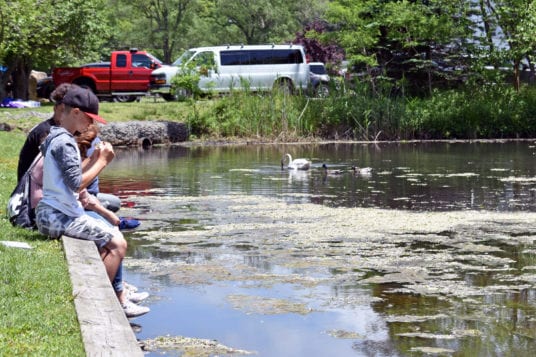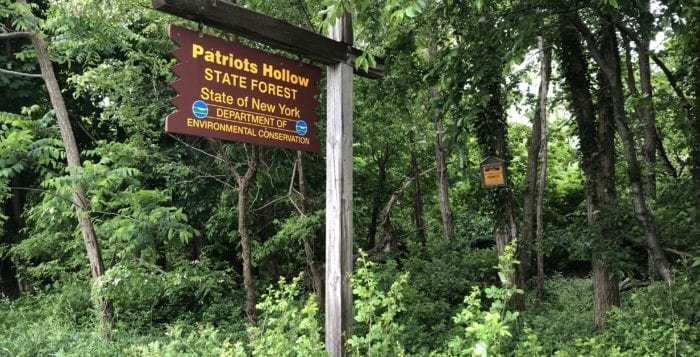Join the Lake Ronkonkoma Improvement Group in keeping Lake Ronkonkoma clean during the Great Brookhaven Cleanup on Saturday, June 16. Volunteers will meet at the Town of Brookhaven’s Michael P. Murphy Beach on Lake Shore Road from 9:30 a.m. to 3 p.m. and walk the shoreline of the lake picking up litter. Students are welcome to use this event for community service hours. Come spend an hour or two making the lake as beautiful as it should be! For further details, call Evelyn at 631-588-7599.
Green Fest 2018 returns to Port Jefferson
Making a difference together
By Heidi Sutton

Seeking to promote an eco-friendly environment and a “greener” lifestyle, the Greater Port Jefferson Chamber of Commerce will sponsor its 10th annual Green Fest on Saturday, June 16 from 1 to 5 p.m.
The free event will once again be held at the Port Jefferson Village Center at 101 East Broadway — a most fitting venue as the community hub is the result of a recycling/renovation of the historic Bayles Shipyard Building — and will feature green market vendors throughout the first floor and outside if the weather is nice.
The annual festival began a decade ago with the goal to educate, inform, entertain and enlighten people on how to make smart choices for a greener world including being energy conscious as a way to reduce our carbon footprint.
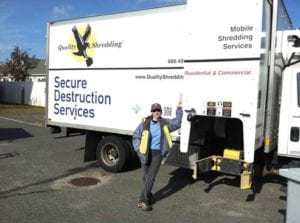
This year’s highlight will be a community shredding event from 1 to 3:30 p.m. by Quality Shredding of Deer Park. “We wanted to make more of an impact and add another dimension to the event,” said Barbara Ransome, director of operations at the chamber. Residents and visitors can bring up to three bags or boxes of personal papers per person to be shredded for free. The mobile truck is capable of shredding up to 10,000 pounds of personal paper.
Entertainment will include a yoga class by Satya Yoga & Pilates Studio in Mount Sinai (mats will be provided), two spiritual drumming circles with shamanic drummer Peter Maniscalco and a performance by improvisational solo street guitarist Jeff Bellanca of Classic Jam 1.
Children will enjoy visiting the Port Jefferson Free Library’s Green Teens table to make a craft using recycled materials and the Sweetbriar Nature Center’s table to see their resident critters. And if your stomach starts rumbling during the event, visit the Sweet Melissa 1932 Farm to Table food truck, specializing in organic nutritional cuisine.

Of course, no festival is complete without a diverse group of over 20 select vendors highlighting green products and services including renewable solar energy, electric/hybrid and smart cars, electric bikes with live demonstrations along with a mini-farmers market offering candles, flowers, plants, soaps, yarn and baked goods for sale.
With so much going on, this family-friendly event is a great way to kick off the summer. Come on down and enjoy the day learning about methods that promote sustainable ways of living that will benefit our environment and planet and make our community a healthier place to live. The first 100 attendees will receive a free canvas bag, courtesy of SERVPRO of Port Jefferson. Making a difference begins with one small step (or fest) at a time.
Co-sponsored by Times Beacon Record News Media, Maggio Environmental Services and SERVPRO of Port Jefferson, the event will be held rain or shine. For more information, call 631-473-1414 or visit www.portjeffgreenfest.com.
Photos courtesy of PJCC
Mt. Sinai Yacht Club’s fleet blessed with safe travels






As members of the Mount Sinai Yacht Club in Cedar Beach came out June 10 for the 15th annual blessing of the fleet, most understood, as old of a tradition it is, the blessing is time-honored way to guarantee
a successful boating season.
“This is for the entire season to make sure [the club’s members] have a safe and fun boating season,” said Reverend Jerry Nedelka, Venerable Canon for the Episcopal Diocese of Long Island. He has conducted
the blessing of the fleet ceremony for nearly two decades. “This is a great opportunity for fellowship among friends and club members.”
This year Nedelka and Reverend Francis Lasrado of Infant Jesus R.C. Church in Port Jefferson, held up a cross and gave blessings to the many boats, both large and small, of the yacht club’s members as they crossed in front of the marina. The reverends even blessed the Town of Brookhaven’s pump out boat as it crawled its way across the harbor to the mouth of the Long Island Sound.
The blessing was attended by club trustee Bill Dick along with various local government officials including
Suffolk County Legislator Sarah Anker (D-Mount Sinai) and Brookhaven Town Councilwoman Jane Bonner (C-Rocky Point).
“This … shows our strong, community-focused mindset,” Dick said.
Anker said the club plays a big park protecting the local harbor front and environment, especially when it comes to the repair of the channel that travels from Mount Sinai Harbor into the Sound, which is constantly affected by erosion and storms.
“They are good stewards of our environment,” Anker said. “They are an anchor in the marina community, and
they have been instrumental in efforts to repair the channel.”
Legislator highlights county parks every day in May
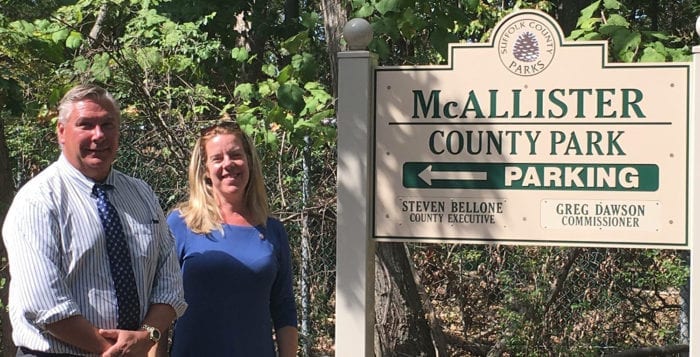
Suffolk residents may not realize it, but the county has enough parkland to explore for an entire 31-day month and then some. Making sure her constituents are fully aware of their outdoor options right in their own backyard has become a mission for Legislator Kara Hahn (D-Setauket).
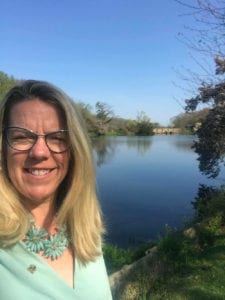
She has been the chair of the Parks & Recreation Committee in Suffolk County since 2016, and upon getting started, said she was excited to start talking about parks. But Hahn didn’t realize how big of a job building awareness was going to be.
“Even in our neighborhood, there were people who had never been to Avalon [Park], people who had never been to the Greenway Trail,” she said. “I couldn’t believe that people didn’t know these things existed.”
In 2017 she kicked off her A Park a Day in May challenge, an initiative designed to get people out and about, visiting one of Suffolk’s dozens of parks to take a selfie and share on social media with the hashtag #APADIM. Hahn said even as the county’s parks chair, in researching and preparing for the now-annual challenge, she encounters green spaces she wasn’t aware of.
“When I became parks chair I said to all of my colleagues, ‘I want to tour all of the parks,’ thinking it was going to be so easy,” she said, adding she was totally mistaken. “It’s awesome.”
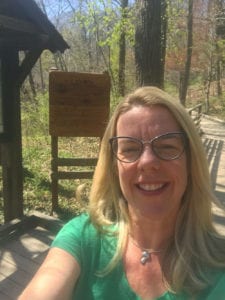
She said she and her family realized a couple of summers back, after taking a family trip to Cape Cod, they were traveling to enjoy experiences that were similar to what could be done back home.
“There’s so much here,” she said. “What we have here — there is no comparison anywhere else.”
Hahn admitted it would be impossible for her as a legislator to visit 31 different parks on 31 consecutive days, so the selfie’s she posts on a given day in May are sometimes taken previously and involve months of planning. She said getting out and visiting parks also affords her the opportunity to speak with constituents and gauge needs at certain parks, like monitoring ticks and funding for more benches.
In addition to her May initiative, Hahn also spearheaded a parks passport program last summer, which encourages kids to explore county parks and keep track of where they’ve been in a green, replica passport.
To see a full list of Suffolk green spaces and activities available at them — like kayaking, hiking and fishing to name a few — visit www.suffolkcountyny.gov/departments/parks/thingstodo.aspx.
Duck Pond Day delivers splash of fun in Wading River






The Shoreham-Wading River Chamber of Commerce hosted the 24th annual Duck Pond Day June 3.
The event included a parade, games and activities, vendors, food and drinks from local chamber businesses.
Man of the Year Rob Nasta, owner of My Creperie in Wading River, was honored for his hard work and dedication and his military service.
Duck Pond Day was started by the civic association as part of a wetlands coastline cleanup effort. The task of sprucing up the ponds turned into a community day where volunteers clean up and then put down their rakes and set up picnics around the ponds. A few years later, the parade was added and as the years passed, Duck Pond Day turned into an annual full-day event.
Smithtown man pleads guilty to scamming Sandy victims
By Sara-Megan Walsh
A Smithtown contractor has pled guilty to scamming Hurricane Sandy victims out of more than $100,000, according to the Nassau County district attorney’s office.
Lee Moser, 49, pleaded guilty to third-degree grand larceny, a class D felony, and first-degree scheme to defraud, a class E felony, June 1 in Nassau County Supreme Court before Justice Robert Bogle.
“Superstorm Sandy savaged our communities, and contractors who defraud those who suffered from the storm’s wrath are especially despicable,” District Attorney Madeline Singas said in a press statement. “This unscrupulous defendant took his victims’ money to help them rebuild, regaled them with excuses for delay and never performed the work.”

From April 2015 to August 2016, Moser signed contracts with five Nassau County homeowners to perform work on their homes that have been severely damaged by Superstorm Sandy, according to Singas. In most of these cases, the defendants wrote Moser a down payment check for the work, using funds from New York Rising, made payable to his business Capstone Remodeling.
New York Rising is the state-run program that assists homeowners impacted by natural disasters. The homeowners had applied for and received money from New York Rising to rehabilitate their homes after they were damaged by the Oct. 29, 2012, storm.
Instead of performing the contracted work, Moser repeatedly provided excuses as to why his business had not started, such as he was in the hospital or caring for his sick mother, according to prosecutors. In total, Singas said he is suspected of stealing $113,485 from Nassau homeowners. Moser allegedly spent these funds on gasoline, dining at restaurants, telephone services and other expenditures to continue running his construction business that were unrelated to the homeowners’ contracts, according to the district attorney’s office.
The Nassau County Office of Consumer Affairs received five complaints from victims of Capstone Remodeling between June 2016 and April 2017, which were forwarded to the district attorney’s office. An investigation immediately commenced.
To date, the district attorney said that Moser is currently an unlicensed contractor and has not attempted to repay any of the homeowners.
Moser is due back in court July 12, where he is expected to be sentenced to 45 days in jail and five years of probation, if he pays $50,000 in restitution to New York Rising and pays the remaining amount while on probation. If he does not pay restitution, he would be sentenced to one year in jail, according to the district attorney’s office.
The Gardener’s Delight: Reclaiming Patriot’s Hollow
By Kyrnan Harvey
I was able to attend a meeting of the Three Village Community Trust last Thursday that addressed the complicated issue of nonnative invasive plants. Guest speaker Luke Gervase of the Long Island Invasive Species Management Area led the discussion that emphasized Patriots Hollow State Forest, the few dozen acres of woods running north and west of Route 25A in Setauket, roughly opposite Stop & Shop. Recently the trust announced that it is working toward a stewardship agreement with the New York State Department of Environmental Conservation, as reported in these pages, to restore the woods, currently impenetrable with fallen and cracked trees and the bittersweet, greenbriar and multiflora rose that have seized the day.
But this is not a virgin forest. English settlers in the 17th century farmed along North Country Road and what would become 25A, and the Setalcotts likely did the same before that.
The Fitzsimmons family started farming there in 1939, growing potatoes, and in ensuing years acquired parcels and rented the land to other farmers. Meanwhile, the Roman Catholic Diocese of Rockville Center owned 30 acres along 25A since the 1960s, which was tilled as late as 1980. In other words, this was more or less open land until the farming was discontinued.
Immediately thereafter began the ecological succession of plants that start germinating in fallow fields. On Long Island these would have first been sun-loving perennials like asters, grasses, boneset (Eupatorium perfoliatum), goldenrods and milkweeds, but also sun-loving woody plants like eastern red cedar, Virginia creeper, poison ivy, Rosa multiflora, sumacs (Rhus spp.), wild raspberries and blackberries (Rubus spp.). Native trees like gray birch and black cherry and exotics, like white mulberry and black locust, soon start displacing the pioneering species.
Desirable successional tree species would be hardwood natives like oaks, sassafras and black gum (Nyssa sylvatica), but 40 years later at Patriots Hollow we have, in this prime location within the Old Setauket Historic District, a vast mess of nonnative invasives like black locust, tree of heaven (Ailanthus) and Norway maple that out-competed other canopy trees like the native red maple, the caterpillar-hosting black cherry and the dignified white oak and have precluded the prosperity of understory natives like shadbush (Amelanchier), arrowwood (Viburnum dentatum), spicebush and American holly, not to mention the potential of an array of wonderful undergrowth perennials.
Restoring Patriots Hollow Forest to a multifunctional habitat (for birds and insects, as well as for human use with trails) by engineering species diversity through vertical layering (canopy trees, understory trees and shrubs, undergrowth perennials) and horizontal layering (woods, edge of woods, open clearing) is a daunting project. It requires a vision, human and financial resources and a coherent set of attainable goals. Cynthia Barnes, president of the board of trustees for the Three Village Community Trust, says that a task force will be meeting to draft some preliminary guidelines and ideas for restoration of this DEC property, including doing an inventory of the flora and fauna and describing the current conditions. The task force will work on hosting facilitated public planning workshops in collaboration with the DEC later this year.
Which brings me back to our speaker, Gervase of the LIISMA, who made the point that it is advised to only gradually remove nonnative invasives, else you are clearing the way for a new wave of opportunistic invasive. For example, if you cut down all the black locusts, then you will quickly get a vast inundation of fast-growing Norway maples. But this presumes there will be little or no maintenance at the site. Thousands of freshly germinated maple seedlings can annually be quickly rubbed out with a scuffle hoe, if there is an integrated management plan in place.
Nor need a rigidly dogmatic approach be adopted. Perhaps some black locusts should be left, ones that have attained to the gnarly character of old age, considering that they are “near native”; that it is not prohibitively difficult to establish understory trees, shrubs and perennials under them and that their wood is for split-rail fencing.
I advocate for a nuanced approach that would be capable of adapting to shifting circumstances and that would be capable of improvising wise decisions midstream.
Kyrnan Harvey is a horticulturist and garden designer residing in East Setauket. For more information, visit www.boskygarden.com.
Photo of the Week
SUSHI FOR LUNCH
Bruce Adams of Northport captured this incredible shot of a bald eagle carrying lunch back to his family in the Town of Huntington on May 10. He writes, ‘Papa Eagle delivers a juicy eel for his two Eaglets and Mama Eagle.’
Send your Photo of the Week to [email protected].
VIDEO: Testing in Port Jeff Harbor to assess Long Island Sound health
A few concerned local citizens are taking the health of the Long Island Sound into their own hands.
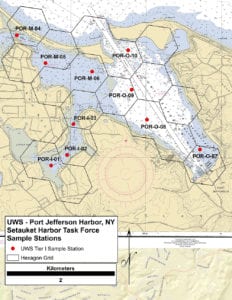
From May through October, nonprofit Save the Sound, an organization dedicated to the health of the body of water, will continue its Unified Water Study: Long Island Sound Embayment Research program for a second year, testing the water conditions in the Sound’s bays and harbors. The program operates through a grant from the Environmental Protection Agency and using a corps of trained testers, called Sound Sleuths, who volunteered to measure dissolved oxygen, chlorophyll, temperature, salinity and water clarity out on the water at dawn twice monthly during the six-month period. Port Jefferson Harbor will be tested by members of Setauket Harbor Task Force, a nonprofit group founded in 2014 to monitor and advocate for the health of the harbor, who volunteered to serve as Sound Sleuths. Setauket Harbor lies within the greater Port Jefferson Harbor Complex.
Task force members George and Maria Hoffman, Laurie Vetere and volunteer Tom Lyon set out in a roughly 15-foot-long motorboat May 25 at 6:30 a.m. to test 10 randomly preselected specific locations in Port Jeff Harbor, with testing equipment provided by Save the Sound, for the second round of research set to take place this spring and summer. The testing needs to be completed within three hours of sunrise in order to ascertain the most valid data possible, according to George Hoffman.
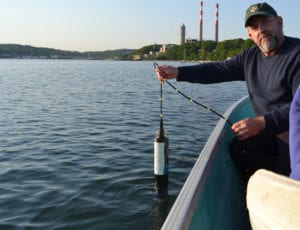
“I know a lot of people are familiar with water testing, but it’s usually about pathogens,” Hoffman said, which often is examined to determine the safety of swimming or eating shellfish. Testing for water chemistry will reveal more about the health of marine life in the harbor. Hoffman discussed the task force’s plans for testing during a May 6 meeting of the Port Jefferson Harbor advisory commission, a group overseen by the Town of Brookhaven that includes representation from all nearby municipalities and also takes up the responsibility of monitoring harbor health.
“We’re not testing for pathogens,” he said. “This is really about harbor health and chemistry.”
Hoffman said while out on the boat May 25 the group tested each of the 10 sites twice — once about a half a meter off the bottom of the harbor and once a half a meter from the surface of the water, using an instrument called a sonde, which is attached to a long cable and submerged in the water. Hoffman said the instrument costs about $30,000.
“That gives us a pretty good idea of what’s happening in the water column,” he said.
Save the Sound explained the importance of testing the chemistry of bays and harbors within the Sound in a May 16 press release announcing the year 2 testing kickoff.

“More than a decade of federally funded monitoring of the open Sound has documented the destructive impact of nitrogen pollution — including algae blooms, red tides, loss of tidal marshes and fish die-offs — and the incremental improvements brought about by wastewater treatment plant upgrades,” the release said. “Conditions in the bays and harbors — where much of the public comes into contact with the Sound — can be different from conditions in the open waters. More testing on bays and harbors is needed to judge the effect of nitrogen on these waterways and what action is needed to restore them to vibrant life.”
Suffolk County Legislator Kara Hahn (D-Setauket), who also chairs the county’s Environment, Planning and Agriculture committee, said while the county has taken up the fight in finding ways to reduce the amount of nitrogen in Long Island’s waters, having dedicated citizens also keeping an eye is an asset.
“That’s critical, these kind of community efforts to protect water bodies,” she said. “It’s special.”
Results of the study will be published in future editions of Save the Sound’s Long Island Sound Report Card.
Environmentalists hope new crab trap regulations will save turtles
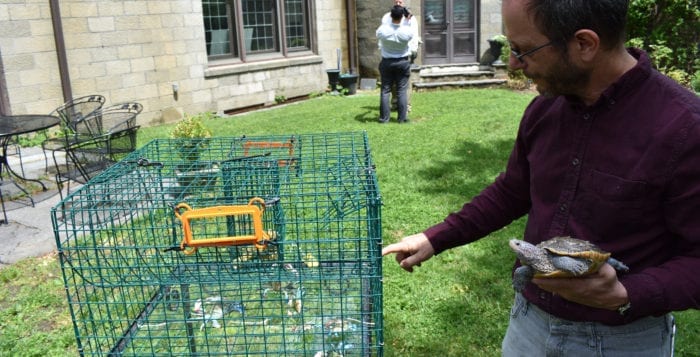
It has been a slow crawl saving Long Island’s turtles, but local conservation groups are hoping new state regulations will speed up the process.
The New York State Department of Environmental Conservation and Long Island environmental groups gathered May 23 at the Suffolk County Environmental Center in Islip to celebrate new rules requiring crab cages — used in Long Island’s coastal waters including many of the bays, harbors and rivers that enter Long Island Sound — to have “terrapin excluder devices” (TEDs) on all entrances. As carnivores, terrapins are attracted to bait fish used in commercial, or what’s known as Maryland style crab traps or “pots.” As a result, male and female turtles of all sizes push their way through the entrance funnels and end up drowning.
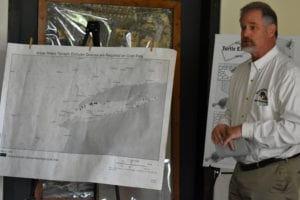
“With each and every season these traps are not required to have TEDs, there are likely hundreds of terrapins that are drowning,” said John Turner, conservation policy advocate for Seatuck Environmental Association, which operates the Islip center. “To me, one of the signs of a real civilized society is how we treat other life-forms. We haven’t treated terrapins very well.”
He said in Stony Brook Harbor alone there are dozens, maybe hundreds of terrapins that will spend the winter in the mud, emerging once the water runs up high enough. Turner said many of the North Shore areas that are home to these turtles, like Setauket Harbor, Conscience Bay, Port Jefferson Harbor, Mount Sinai Harbor and Nissequogue River, play a key role in preserving the species.
“In contrast to where I am in South Jersey, I can go by the canals and I can see a dozen [terrapin] heads bobbing up and down,” said James Gilmore, director of the marine resources division at the state DEC. “Here, it’s very rare to see one. Hopefully these new rules will help us see more.”
Gilmore said the DEC began working on changing state regulations in 2013 but have known long before there was a problem.
Carl LoBue, The Nature Conservancy’s New York ocean program director, said it was in the late 1990s he’d witnessed recreational crab traps in Stony Brook Harbor. One day he lifted a cage out of the water while trying to move his landlord’s boat and saw it was filled with trapped terrapins. Two were still alive, but five
had already drowned.
“With each and every season these traps are not required to have TEDs, there are likely hundreds of terrapins that are drowning.”
— John Turner
“I’m sure the crabber wasn’t intent to kill turtles,” LoBue said. “But when I looked across the bay at the 60 or something crab traps this person had set, I was crushed thinking of the terrapins drowning at that very moment.”
In the early 2000s terrapins became a popular meal in New York, but the harvest of those turtles led to a massive decrease in population, especially the diamondback terrapin, which was identified as a species of greatest conservation need in the 2015 New York State Wildlife Action Plan. In September 2017 the DEC passed regulations banning the commercial harvest of diamondbacks.
Terrapin population has slowly increased since then, but researchers say there’s still little known about the population, like life expectancy or habits while in water. The species has a very slow birth rate, with low local clutches of 10 or so eggs — sometimes only one or two of which hatch and mature.
Russell Burke, a professor of biology at Hofstra University, said terrapins could live very long lives, pointing to older specimens he has seen living to 60 years old, but he estimated some could be twice that age. While Burke said it’s hard to estimate the total population on Long Island, he said in Jamaica Bay alone, he knows there are approximately 3,500 adult females.

The TED devices are 4 3/4 inches by 1 3/4 inches, an exact measurement, to ensure that while crabs can get through, turtles cannot. According to Kim McKown, leader of the Marine Invertebrate and Protected Resources Unit at the state DEC, the small, plastic TEDs cost $10 for the three needed to secure a normal crab trap. The cost exponentially increases depending on how many traps a fisherman has, with some owning up to 1,000 traps.
Turner said his organization used its own funds and purchased 5,000 TEDs and gifted them to the DEC. The state agency is giving them to Long Island crab fishermen on a first come, first served basis.
Commercial crab fisherman Fred Chiofolo, who hunts in Brookhaven Town along the South Shore, experimented with TEDs on his own for years before the regulations were passed. He said the devices
even improved the number of crabs caught.
“It made a significant difference with the pots that had them versus the pots that didn’t,” Chiofolo said. “Last year I put them in every pot I had — about 200 of them. I’m not going to lie it’s a lot of work to put them in, but we don’t want to catch the turtle. I don’t want them, and [the TED] does keep them out.”









